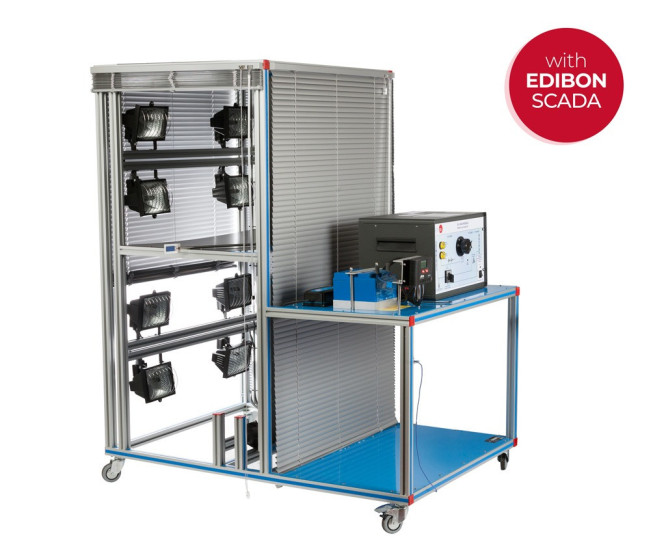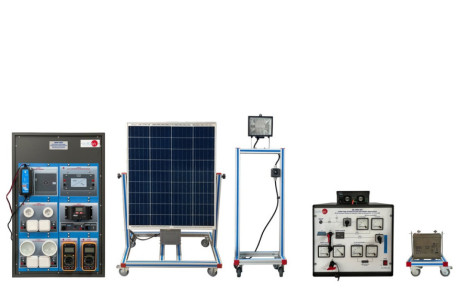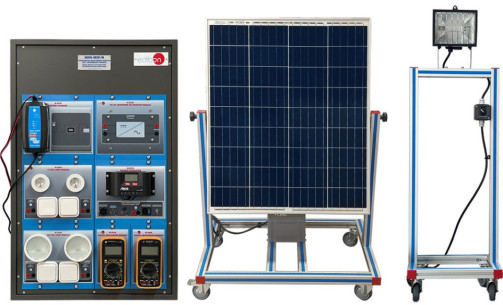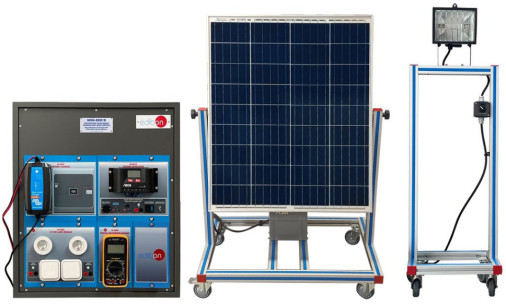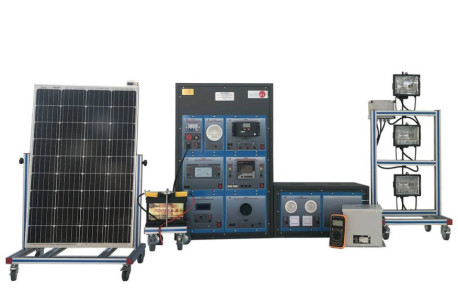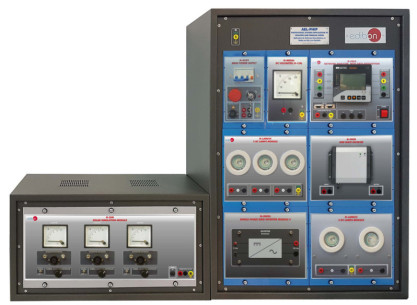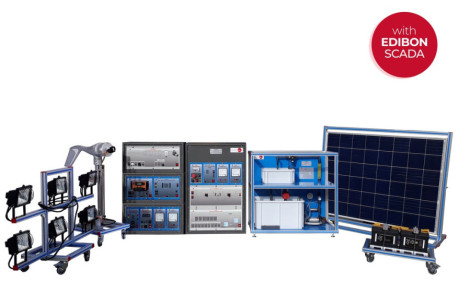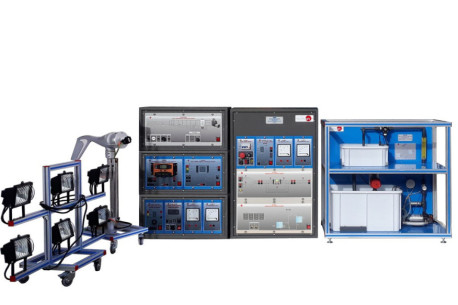EESFC Peralatan Energi Surya Fotovoltaik, Dikendalikan dari Komputer (PC)
SISTEM INOVATIF
The Computer Controlled Photovoltaic Solar Energy Unit, "EESFC", includes equipment that uses the photo-conversion law, which directly converts solar radiation into electricity. The absorbed energy is provided by simulated solar radiation, which in our case is supplied by a panel with powerful light sources (solar lamps).
Ekspansi
Laboratorium
BERITA TERKAIT
GAMBARAN UMUM
The Computer Controlled Photovoltaic Solar Energy Unit, "EESFC", includes equipment that uses the photo-conversion law for the direct conversion of solar radiation into electricity. The absorbed energy is provided by simulated solar radiation, which in our case is supplied by a panel with powerful light sources (solar lamps).
The unit contains:
- Photovoltaic solar panels.
- Solar simulator composed of solar lamps.
- Ventilation system.
- DC load and battery charger regulator.
- Auxiliary battery charger.
- Battery.
- DC Loads module.
- Sensors (temperature, light radiation, DC current and DC voltage).
This Computer Controlled Unit is supplied with the EDIBON Computer Control System (SCADA), and includes: The unit itself + a Control Interface Box + a Data Acquisition Board + Computer Control, Data Acquisition and Data Management Software Packages, for controlling the process and all parameters involved in the process.
LATIHAN DAN PRAKTEK PEDOMAN
LATIHAN PRAKTIS YANG DIANDAL TERMASUK DALAM PANDUAN
- Identification and familiarization with all components of the unit and how they are associated with its operation.
- Determination of the solar panel characteristic parameters.
- Study of the materials that make up the solar cell.
- Study of the p and n sides of a solar cell.
- Study of the I-V and P-V curves.
- Study of the inverse current or the saturation current.
- Study of V, I and W according to different loads.
- Measurement of the open-circuit voltage and the short-circuit current for a solar panel with load.
- Measurement of the maximum power for a solar panel with load.
- Study of the relationship between power generated and solar radiation power.
- Study of the solar panel maximum power.
- Study of the influence of temperature on the solar panel opencircuit voltage.
- Determination of the photo-conversion efficiency.
- Study of the efficiency of the solar panels connected in parallel.
- Study of the efficiency of the solar panels connected in series.
- Study of the efficiency, depending on the temperature, of the photovoltaic system connected in parallel.
- Study of the operation of the photovoltaic generation system supplying power to different DC loads without an auxiliary battery.
- Study of the photovoltaic power generation system operation with an auxiliary battery and supplying different DC/AC loads.
- Study of the operation of the photovoltaic system in series/parallel with connection of different loads and without the support of the storage battery.
- Study of the operation of the photovoltaic system in series/parallel with connection of different loads DC and with the support of the storage battery.
LEBIH BANYAK LATIHAN PRAKTIS YANG AKAN DILAKUKAN DENGAN UNIT
- Sensors calibration.
- Lamps illumination profile study.
- Determination of the resistance of a solar cell connected in series and in parallel.
- Study of the parameters that define the quality of a solar cell.
- Study of the dependence of the voltage of open circuit (V∞) on the lumens.
Practices to be done with the OPTIONAL KIT "EE-KIT":
- Study of the operation of the photovoltaic system in series/parallel with connection of different loads and without the support of the storage battery.
- Study of the operation of the photovoltaic system in series/parallel with connection of different AC loads and with the support of the storage battery.
- Study of the connection of loads to an alternating voltage of 220V.
Practices to be done with the additional recommended element "EE-HYB-KIT":
- Study of the hybrid inverter’s grid connection procedure: correct sequence of battery and grid switches.
- Study of the hybrid inverter configuration.
- Study of the hybrid inverter in grid connection mode.
- Study of the hybrid inverter in island mode.
- Study of the behavior of the hybrid inverter in the event of a blackout.
- Study of the charging process of the battery from the laboratory grid through the hybrid inverter.
- Study of the battery charging process from a renewable energy source.
- Study of the power flows of the battery and the grid under variations of the energy demand with the variable resistive load.
- Study of the response of the hybrid inverter when the critical discharge point of the battery is reached.
- Study of the energy balance between the battery-charge-grid by means of the analog ammeters and voltmeters incorporated in the kit.
Other possibilities to be done with this Unit:
- Many students view results simultaneously. To view all results in real time in the classroom by means of a projector or an electronic whiteboard.
- Open Control, Multicontrol and Real Time Control. This unit allows intrinsically and/or extrinsically to change the span, gains, proportional, integral, derivative parameters, etc, in real time.
- The Computer Control System with SCADA and PID Control allow a real industrial simulation.
- This unit is totally safe as uses mechanical, electrical and electronic, and software safety devices.
- This unit can be used for doing applied research.
- This unit can be used for giving training courses to Industries even to other Technical Education Institutions.
- Control of the EESFC unit process through the control interface box without the computer.
- Visualization of all the sensors values used in the EESFC unit process.
- By using PLC-PI additional 19 more exercises can be done.
- Several other exercises can be done and designed by the user.
PERALATAN SIMILAR TERSEDIA
Peralatan Modular Energi Surya Fotovoltaik (Versi Lengkap)
Peralatan Modular Energi Surya Fotovoltaik (Versi Menengah)
Peralatan Modular Energi Surya Fotovoltaik (Versi Dasar)
Aplikasi Fotovoltaik Terhubung ke Jaringan
Aplikasi Sistem Fotovoltaik Terisolasi dari Jaringan
Aplikasi Pembangkit Listrik Tenaga Surya, Dikendalikan dari Komputer (PC)
Aplikasi Sistem Fotovoltaik di Jaringan Terisolasi dan Paralel
PERALATAN KOMPLEMENTER
Aplikasi Pembangkit Listrik Tenaga Surya, Dikendalikan dari Komputer (PC)
Aplikasi Fotovoltaik Terhubung ke Jaringan
Aplikasi Sistem Fotovoltaik di Jaringan Terisolasi dan Paralel
Aplikasi Sistem Fotovoltaik Terisolasi dari Jaringan
Aplikasi Pemompaan untuk Jaringan Terisolasi, Dikendalikan dari Komputer (PC)
Aplikasi Pemompaan untuk Jaringan Terisolasi
Peralatan Energi Surya Fotovoltaik
Peralatan Modular Energi Surya Fotovoltaik (Versi Lengkap)
Peralatan Modular Energi Surya Fotovoltaik (Versi Menengah)
Peralatan Modular Energi Surya Fotovoltaik (Versi Dasar)
KUALITAS

LAYANAN PURNA JUAL

 Preferensi cookie
Preferensi cookie

